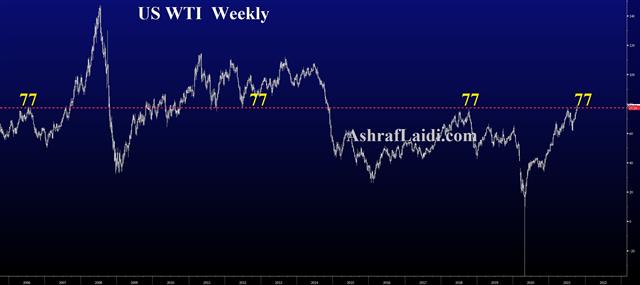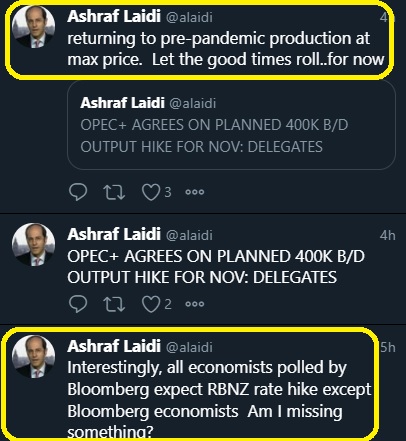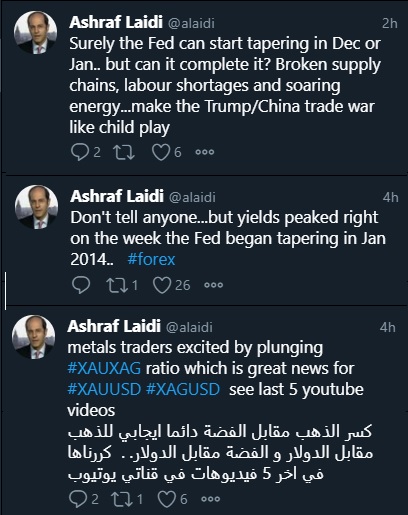Intraday Market Thoughts Archives
Displaying results for week of Oct 03, 2021Soft Jobs Tee Up Taper Magnitude
The US added 194K jobs in September, well shy of the 500K expected. That immediately led to a 20-40 pip drop in the US dollar and falling Treasury yields. In about an hour, both moves reversed and a big reason why was positive details in the report. Upward revisions to the two prior reports added 194K jobs and the unemployment rate fell to 4.8% from 5.1%. Wage growth was solid and there was talk about seasonal adjustment errors around educational assistants, weighing heavily on the government category.
One place where the USD didn't recover was against the loonie and that's because Canada added 157K jobs itself in August, including 194K full time. That's as many as in the US in a country one-tenth the size. USD/CAD fell through the September low and 1.2500 on the report. A head-and-shoulders top has formed in the pair targeting 1.20. Given the strength in oil and technical setup, there's plenty to like about the loonie on a number of fronts. CADJPY may be set to hit 90.70.
Note also that China returned from holiday on Friday and the mood around Evergrande appears to have improved. The company is headed for default but there's an increasing sense (hope?) that the sector can be ring fenced and that the rest of the economy can prosper. Shanghai stocks rose 0.7% on Friday.
Energy Fever Breaks

The monumental move in European gas and energy prices ratcheted up to a new level on Wednesday, rocketing 40% higher at one point. However, the move reversed and prices finished 10% lower, in part due to comments from Putin suggesting Russia could add incremental supply.
It's far too early to call a top for certain, but the spike higher and reversal has all the technical elements of a blow off following a parabolic move. A cold winter could ultimately leave parts of Europe in a dire situation but that's undoubtedly priced in already. There's also a fair chance that hedges or a short squeeze added to the move.
Gas prices in Europe and North America, along with oil, all carved out bearish outside days and that rippled through broader markets, leading to a recovery in European equities. German stocks in particular may be a clear beneficiary if energy prices stabilize or decline.
Tail risks also fell in the US as Congressional leaders signaled a short-term truce on the debt ceiling, pushing the deadline to December. That will give Democrats time to add it to a reconciliation bill or we'll do this dance again in two months. In any case, markets breathed a sigh of relief from another manufactured crisis.
Ultimately, it will be the economy that decides were markets go. The ADP employment report has been a poor jobs tracker but it foreshadowed weak non-farm payrolls in August. Wednesday's report showed 568K jobs compared to 428K expected.80 Oil & Lasting Inflation Fears

There's no single catalyst behind the recent slump in global equities. Lately market watchers are pointing to the debt ceiling but we've been through this song-and-dance many times and are confident the US won't default on its debt.
Covid is clearly fading in the market's mind. Shares of vaccine makers have been falling and weekend cinema box office numbers were at post-pandemic highs. Nonetheless, there's still lasting fear and concern about structural changes that have been triggered by the pandemic.
China and Evergrande are certainly concerns, but the market has a long history of ignoring problems, expecting Beijing to step in to prop up growth and being right. We fear that 'common prosperity' is a sign of a generational shift in policymaking but until there are concrete changes, it's difficult to price in a regime change.
Supply chain issues are clearly getting worse. Ports are backed up and there's talk about empty shelves for Christmas. It's an issue we haven't seen before and it's next-to-impossible to obtain good data on how it will resolve --- yet eventually it will -- and there are positive read-throughs around inventory building in 2023 and beyond.
But none of that takes into consideration the impact of inflation. Surveys increasingly show that businesses plan to raise prices. Workers are also asking for wages. The Fed doggedly points to market-based measures of inflation but with QE, the Fed also has a thumb on the scale.
As yields inevitably rise, the noise around inflation will grow louder. Nasdaq is now overwhelmingly seen as a long duration asset and it's 8% off its highs. Tech has carried much of the pandemic recovery, and we'd note that 62% of stocks in the S&P 500 are down 10% from their 52-week highs, while 16% are down 20%. That's beginning to show up in the high-flying tech stocks that have done so much heavy lifting in the past 18 months.
Looking ahead, at 1400 GMT, the ISM non-manufacturing survey is due up. The prior reading was 61.7 and it's expected to dip to 60. Within the report, the prices paid component was previously at 75.4 and a further rise would re-energize the inflationary chorus.
Peculiar Intermarket Moves

In the trade deal, China had agreed to purchase an additional $200B of US exports but US Trade Representative Katherine Tai will announce Monday that China is not complying with purchases running at 62% of target with only three months remaining.
The report says the USTR will float tariffs as one possible response. No doubt China will point to the impacts of the pandemic as one reason for the shortfall.
The market was in a good mood on Friday and that carried over into early-week trade. US August PCE core inflation rose 3.6% y/y, matching the consensus. Within the report was a reminder that the US savings rate – at 9.4% -- remains remarkably high. Along with inventory rebuilding, that will be a lasting tailwind for growth.
Part of the reason for Friday's market optimism in markets was a drug from Merck that was tested on people who had mild-to-moderate covid symptoms for five days and other risk factors. The anti-viral pill lowered the chance of hospitalization by 50% and the results were so encouraging that US officials ended the trial early. The pill may ultimately go a long way toward one day getting back to 'normal' life. But the stagflationary confusion continues to weigh on sentiment.







